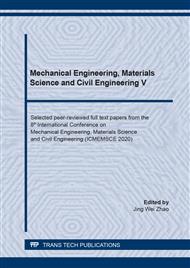[1]
D. Dissanayake, C. Jayasinghe, M. Jayasinghe, A comparative embodied energy analysis of a house with recycled expanded polystyrene (EPS) based foam concrete wall panels, Energy Build. 135 (2016) 85-94.
DOI: 10.1016/j.enbuild.2016.11.044
Google Scholar
[2]
Instituto Nacional de Normalización. Nch853. Acondicionamiento térmico – Envolvente térmica de edificios – Cálculo de resistencias y transmitancias térmicas. (2007) 1-51.
Google Scholar
[3]
M. Aktacir, O. Büyükalaca, T. Yılmaz, A case study for influence of building thermal insulation on cooling load and air-conditioning system in the hot and humid regions, Applied Energy. 87 (2010), 599-607.
DOI: 10.1016/j.apenergy.2009.05.008
Google Scholar
[4]
N. Ramli, S. Mustapa, M. Abdul, Application of expanded polystyrene (EPS) in buildings and constructions: A review. J. Applied Polymer Science. 136 (2018) 1-11.
DOI: 10.1002/app.47529
Google Scholar
[5]
I. Gnip, V. Kersulis, S. Vejelis, S. Vaitkus, Water absorption of expanded polystyrene boards, Polymer Testing. 25 (2006) 635-641.
DOI: 10.1016/j.polymertesting.2006.04.002
Google Scholar
[6]
W. Shi, L. Miao, J. Luo, J. Wang, Y. Chen, Durability of Modified Expanded Polystyrene Concrete after Dynamic Cyclic Loading. Shock & Vibration. (2016) 1-7.
DOI: 10.1155/2016/2391476
Google Scholar
[7]
N. Liu, B. Chen, Experimental study of the influence of EPS particle size on the mechanical properties of EPS lightweight concrete, Constr. Build Mater. 68 (2014) 227-232.
DOI: 10.1016/j.conbuildmat.2014.06.062
Google Scholar
[8]
A. Sayadi, J. Tapia, T. Neitzert, G. Clifton, Effects of expanded polystyrene (EPS) particles on fire resistance, thermal conductivity and compressive strength of foamed concrete, Constr. Build Mater. 112 (2016) 716-724.
DOI: 10.1016/j.conbuildmat.2016.02.218
Google Scholar
[9]
A. Brooks, H. Zhou, D. Hanna, Comparative study of the mechanical and thermal properties of lightweight cementitious composites, Constr. Build Mater. 159 (2018) 316-328.
DOI: 10.1016/j.conbuildmat.2017.10.102
Google Scholar
[10]
Y.X. Rao, C.F. Liang, Y.Xia, Experimental research on physical and mechanical properties of EPS recycled concrete, AMM. 204-208 (2012) 4022-4025.
DOI: 10.4028/www.scientific.net/amm.204-208.4022
Google Scholar
[11]
American Society for Testing and Materials. ASTM C150. Standard Specification for Portland Cement.
Google Scholar
[12]
American Society for Testing and Materials. ASTM C33/C33M. Standard Specification for Lightweight Aggregates for Structural Concrete.
Google Scholar
[13]
American Society for Testing and Materials. ASTM C494. Standard Test Method for Slump of Hydraulic-Cement Concrete.
Google Scholar
[14]
American Society for Testing and Materials. ASTM C1602/C1602M. Standard Specification for Mixing Water Used in the Production of Hydraulic Cement Concrete.
Google Scholar
[15]
Information on https://www.northeastern.edu/dataresources/minitab/.
Google Scholar
[16]
American Concrete Institute. ACI 213R-14. Guide for structural lightweight-aggregate concrete.
Google Scholar
[17]
American Society for Testing and Materials. ASTM C192 / C192M. Standard Practice for Making and Curing Concrete Test Specimens in the Laboratory.
Google Scholar
[18]
American Society for Testing and Materials. ASTM C31/C31M. Standard Practice for Making and Curing Concrete Test Specimens in the Field.
Google Scholar
[19]
American Society for Testing and Materials. ASTM C567.Standard Test Method for Determining Density of Structural Lightweight Concrete.
Google Scholar
[20]
American Society for Testing and Materials. ASTM C39. Standard Test Method for Compressive Strength of Cylindrical Concrete Specimens.
Google Scholar
[21]
American Society for Testing and Materials. ASTM C177. Standard Test Method for Steady-State Heat Flux Measurements and Thermal Transmission Properties by Means of the Guarded-Hot-Plate Apparatus.
DOI: 10.1520/c0177
Google Scholar
[22]
S.H. Perry, P.H. Bischoff, K. Yamura, Mix details and material behaviour of polystyrene aggregate concrete, Mag. Concr. Res. 43(1991) 71-76.
DOI: 10.1680/macr.1991.43.154.71
Google Scholar
[23]
Y.Xu, L. Jiang, J. Xu, Y.Li, Mechanical properties of expanded polystyrene lightweight aggregate concrete and brick, Constr. Build Mater. 27 (2012) 32-38.
DOI: 10.1016/j.conbuildmat.2011.08.030
Google Scholar
[24]
D. González, E.A. Restrepo, H. Gil, Characterization and Evaluation of Lightweight Fly Ash Concrete Modified with EPS, Int. J. Civ. Eng. Technol. 10 (2019) 288-304.
Google Scholar
[25]
E. Thanon, A. Jihad, Proportioning of Lightweight Concrete by the Inclusions of Expanded Polystyrene Beads (EPS) and Foam Agent, TJES. 23 (2016) 65-73.
DOI: 10.25130/tjes.23.2.08
Google Scholar
[26]
D. Saradhi, K. Ganesh, Behaviour of lightweight expanded polystyrene concrete containing silica fume, Cem. Concr. Res. 33 (2003) 755-762.
DOI: 10.1016/s0008-8846(02)01055-4
Google Scholar
[27]
D. Saradhi, K. Ganesh, W. Tiong-Huan, Effect of polystyrene aggregate size on strength and moisture migration characteristics of lightweight concrete, Cem. Concr. Compos. 28 (2006) 520-527.
DOI: 10.1016/j.cemconcomp.2006.02.018
Google Scholar
[28]
İ.Bekir, B. Işıkdağ, Effect of expanded perlite aggregate on the properties of lightweight concrete, J. Mater. Process. Technol. 204 (2008) 34-38.
DOI: 10.1016/j.jmatprotec.2007.10.052
Google Scholar
[29]
D.W. Sundstrom, Y. D. Lee, Thermal conductivity of polymers filled with particulate solids, J. Appl. Polym. Sci. 16 (1972) 3159-3167.
DOI: 10.1002/app.1972.070161210
Google Scholar
[30]
J. F. Wang, J. K. Carson, M. F. North, A new approach to modelling the effective thermal conductivity of heterogeneous materials, Int. J. Heat Mass Transf. 49 (2006) 3075-3083.
DOI: 10.1016/j.ijheatmasstransfer.2006.02.007
Google Scholar
[31]
D. Campbell-Allen, C.P. Thorne, The thermal conductivity of concrete, Mag. Concr. Res. 15 (1963) 39-48.
Google Scholar
[32]
Y. Xu, L. Jiang, J. Liu, Y. Zhang, J. Xu, G. HE, Experimental study and modeling on effective thermal conductivity of EPS lightweight concrete, J. Therm. Sci. Technol. 11(2016).
DOI: 10.1299/jtst.2016jtst0023
Google Scholar
[33]
O. Sengul, S. Azizi, F. Karaosmanoglu, M.A. Tasdemir, Effect of expanded perlite on the mechanical properties and thermal conductivity of lightweight concrete, E nergy Build. 43 (2011) 671-676.
DOI: 10.1016/j.enbuild.2010.11.008
Google Scholar
[34]
R. Demirboga, R. Gül, Thermal conductivity and compressive strength of expanded perlite aggregate concrete with mineral admixtures, Energy Build. 35 (2003) 1155-1159.
DOI: 10.1016/j.enbuild.2003.09.002
Google Scholar
[35]
S. Abidi, B. Nait- Ali, Y. Joliff, C. Favotto, Impact of perlite, vermiculite and cement on the thermal conductivity of a plaster composite material: Experimental and numerical approaches, Compos. B. Eng. 68 (2015) 392-400.
DOI: 10.1016/j.compositesb.2014.07.030
Google Scholar
[36]
Fédération Internationale de la Précontrainte, FIP Manual of lightweight aggregate concrete, second ed., Glasgow & London: Surrey University Press, 1983, pp.1-259.
Google Scholar
[37]
T.A. Holm, T. W. Bremmer, State-of-the-art report on high-strength, highdurability structural low-density concrete for applications in severe marine environments, Washington, DC.
Google Scholar
[38]
T.A. Harrison, Early age thermal crack control in concrete, CIRIA Report 91, London, 1992, pp.1-57.
Google Scholar


